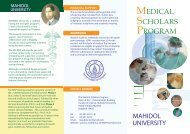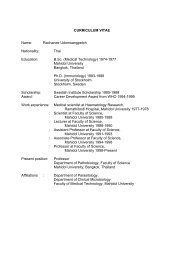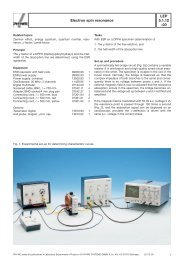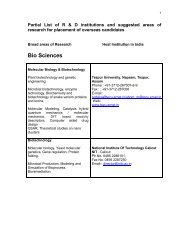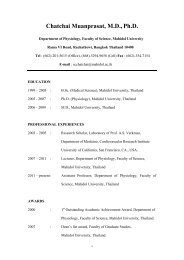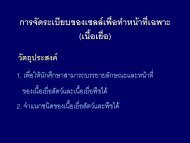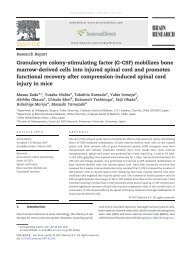Suggestions for preparing your presentation Do not expect the ...
Suggestions for preparing your presentation Do not expect the ...
Suggestions for preparing your presentation Do not expect the ...
You also want an ePaper? Increase the reach of your titles
YUMPU automatically turns print PDFs into web optimized ePapers that Google loves.
<strong>Suggestions</strong> <strong>for</strong> <strong>preparing</strong> <strong>your</strong> <strong>presentation</strong><br />
<strong>Do</strong> <strong>not</strong> <strong>expect</strong> <strong>the</strong> audience to know anything about <strong>your</strong> project.<br />
You need to give <strong>the</strong> in<strong>for</strong>mation necessary in <strong>the</strong> introduction so that anyone can understand<br />
what you are doing.<br />
What is <strong>the</strong> question you are investigating?<br />
The research objective is <strong>not</strong> just <strong>the</strong> experiments you per<strong>for</strong>med.<br />
Think about <strong>the</strong> big picture and how <strong>your</strong> work fits into it.<br />
Make <strong>your</strong> research objective concise and understandable to anyone, even people <strong>not</strong><br />
knowledgeable about <strong>your</strong> field.<br />
Make sure <strong>the</strong> research objective can get <strong>the</strong> attention of <strong>your</strong> audience and make <strong>the</strong>m want to<br />
listen to <strong>your</strong> <strong>presentation</strong>.<br />
Know <strong>the</strong> difference between a technique and an experimental question.<br />
The title of you slide should be <strong>the</strong> take home message or conclusion of <strong>the</strong> slide. <strong>Do</strong>n’t use slide titles<br />
such as “Introduction, Methods, or Results”.<br />
Think of <strong>your</strong> <strong>presentation</strong> as a story that you are telling <strong>the</strong> audience. <strong>Do</strong>n’t move from one slide to<br />
<strong>the</strong> next without a transition.<br />
Explain <strong>not</strong> only what you did but also why you did it. If you want <strong>the</strong> audience to follow <strong>your</strong><br />
<strong>presentation</strong> don’t make <strong>the</strong>m spend time guessing why you are doing <strong>the</strong> experiments. Remember it<br />
is <strong>your</strong> job to teach <strong>the</strong> audience about <strong>your</strong> topic.<br />
Never show a result without interpreting <strong>the</strong> data. <strong>Do</strong>n’t <strong>expect</strong> <strong>the</strong> audience to figure out what <strong>the</strong><br />
results mean without you telling <strong>the</strong>m.<br />
Cartoons and models are more in<strong>for</strong>mative than a slide full of text. Always used a model or cartoon<br />
with <strong>the</strong> text.<br />
Know <strong>the</strong> difference between a summary of <strong>your</strong> results and <strong>the</strong> conclusions that can be drawn from<br />
<strong>the</strong> results.<br />
Choose a color scheme that is easy to see. Avoid using yellow on a white background and red on a<br />
blue background. Your slide will look different when projected than when you look at <strong>the</strong>m on <strong>your</strong><br />
computer screen.<br />
Use fonts that are easy to read such as Arial and o<strong>the</strong>r similar fonts. <strong>Do</strong>n’t make it hard <strong>for</strong> <strong>your</strong><br />
audience to read <strong>your</strong> text.<br />
Label <strong>your</strong> figures clearly. Make <strong>the</strong> font of <strong>the</strong> text large enough to be seen in <strong>the</strong> back of <strong>the</strong> room.<br />
If <strong>the</strong> figure it too complicated <strong>the</strong> audience will <strong>not</strong> understand. Make several simple figures instead<br />
of one complicated figure.
SCBC606 Research Seminar Course<br />
Some things to consider when <strong>preparing</strong> <strong>your</strong> seminar<br />
Try to tell a story <strong>not</strong> just report <strong>your</strong> data.<br />
Sometimes this will mean presenting <strong>the</strong> results in a different order than you did <strong>the</strong> experiments.<br />
Give enough background so people unfamiliar with <strong>your</strong> field of study can understand <strong>not</strong> only<br />
what you are doing but why. The rationale <strong>for</strong> <strong>the</strong> experiments is very important.<br />
Explain clearly what <strong>the</strong> questions you are going to address in <strong>your</strong> <strong>presentation</strong>.<br />
If you are using techniques that are complicated or difficult <strong>for</strong> people unfamiliar with <strong>the</strong><br />
technique to understand make sure you teach people about <strong>the</strong> technique first. <strong>Do</strong>n’t give <strong>the</strong><br />
intricate details of <strong>the</strong> experimental protocol but explain in general what in<strong>for</strong>mation you will get<br />
out of <strong>the</strong> experiment and a little about how <strong>the</strong> experiment was per<strong>for</strong>med.<br />
<strong>Do</strong> <strong>not</strong> put too much data into <strong>the</strong> <strong>presentation</strong>. If you do <strong>not</strong> have time to give a good<br />
explanation about <strong>the</strong> results <strong>the</strong>n do <strong>not</strong> include <strong>the</strong>m. Also if <strong>the</strong> results do <strong>not</strong> fit with <strong>your</strong><br />
story you may want to leave <strong>the</strong>m out.<br />
It is okay to have a couple of sections. If all of <strong>your</strong> results don’t fit a single story tell <strong>the</strong>m both<br />
but separately. But try to tie <strong>the</strong>m toge<strong>the</strong>r at <strong>the</strong> end.<br />
Figures <strong>for</strong> publications are <strong>not</strong> always good <strong>for</strong> <strong>presentation</strong>s. The audience will have a short<br />
time to look at <strong>the</strong> figure and it should be simple enough that <strong>the</strong> audience can understand it in a<br />
short time. Too much in<strong>for</strong>mation on a slide generally results in very little in<strong>for</strong>mation being<br />
conveyed to <strong>the</strong> audience.<br />
Organization<br />
INTRODUCTION<br />
RESEARCH QUESTIONS<br />
RESULTS AND DISCUSSION (results alone are <strong>not</strong> in<strong>for</strong>mative you need to tell <strong>the</strong> audience<br />
what <strong>the</strong> results mean and what you learned)<br />
SUMMARY AND CONCLUSIONS (<strong>the</strong>se are <strong>not</strong> <strong>the</strong> same, you can briefly summarize <strong>your</strong><br />
results but <strong>the</strong>n you need to tell <strong>the</strong> audience how <strong>your</strong> results fit into <strong>the</strong> big picture)<br />
FUTURE DIRECTIONS (what you plan to do and hope to learn, again try to make this a general<br />
idea and <strong>not</strong> be too specific about experimental details)




